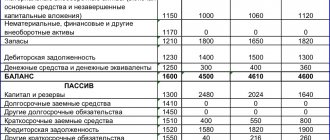The financial results report is a document that is part of the annual accounting reports and contains information about the results of the organization’s activities for the year. Legal entities submit it annually before March 31, along with a balance sheet and other forms.
An integral part of the annual accounting report is the statement of financial results (Form 2), which all legal entities subject to the Federal Law “On Accounting” are required to submit to the Federal Tax Service by March 31 of the year following the reporting year.
IMPORTANT!
By Order of the Ministry of Finance of Russia dated April 19, 2020 No. 61n, numerous changes were made to filling out the report on financial results. Organizations are required to use the new form starting with reporting in 2020.
Traditionally, the financial performance statement contains data on the financial results of activities in the reporting period and is compiled according to the codes of the balance sheet lines and other reporting forms. All indicators are entered into the document on a cumulative basis from the beginning of the year and must correspond to the lines of the balance sheet and income tax return.
IMPORTANT!
Organizations specified in Part 4 of Art. 6 of Federal Law No. 402-FZ dated 06.12.2011, that is, small businesses, can use a simplified form of reporting financial results.
Write-off of administrative and commercial expenses to cost price
Write-off of administrative and commercial expenses occurs through the 90th account as follows:
- Dt 90 subaccount “Administrative expenses” Kt 26;
- Dt 90 subaccount “Business expenses” Kt 44.
Let's dwell on the choice of method for writing off expenses from the 26th account.
An organization can choose and record in its accounting policy one of 2 methods of writing off to the following accounts:
- 20 (23, 29);
- 90.
With method 1, general business expenses participate in the formation of the full cost of finished products, ending up in cost accounts in full at the end of the month. They can be distributed between main, auxiliary and service industries, as well as between types of products. In the future, from the 20th (23rd, 29th) account, these expenses will go to the finished product accounts and will be written off in proportion to the volume of products sold to the cost price.
With the 2nd method, the financial result includes the entire amount of general business expenses incurred during the month, without being distributed between the products sold and those remaining in the warehouse. The 2nd method makes it much easier to write off expenses from the 26th account, and also increases expenses, reducing profits. The organization must describe the choice of method for writing off general business expenses in its accounting policy.
The chart of accounts does not allow you to choose which account to write off sales expenses to - only to the 90th one. However, the organization can choose whether to write them off completely or partially. Partial write-off implies a monthly distribution between goods sold and those remaining in the warehouse:
- for manufacturing companies - packaging and delivery costs;
- for trading companies - delivery costs.
Other items of selling expenses are written off in full.
Read about the distribution of delivery costs in the article “How to correctly calculate transport costs (nuances)?”
Determination of financial results for core activities
Postings to subaccounts of the 90th account are made throughout the year, accumulating the amounts of income and expenses. This approach makes it easy to generate the appropriate lines in the income statement. To obtain information about the organization's performance for the month, the accountant calculates expenses (turnover on the debit of the 90th account) and income (turnover on the credit of the 90th account). The difference between these values is profit or loss for the month; this value is reflected by posting Dt 90.9 Kt 99 when making a profit or Dt 99 Kt 90.9 when receiving a loss.
As a result, by the end of the year, a final balance will be formed on all subaccounts used by the organization, which must be reset to zero. For subaccounts with a debit balance, an entry for its full amount is made on the credit of this subaccount and the debit of subaccount 90.9, for subaccounts with a credit balance - vice versa:
Dt 90.1 Kt 90.9
Dt 90.9 Kt 90.2
Dt 90.9 Kt 90.3, etc.
Sales analysis is one of the main aspects that must be taken into account when developing an organization's marketing policy. Therefore, it is important to set up the correct analytics for account 90. Most often, sales analysis is carried out by type of product, by geographic location, by counterparty, by structural division of the organization, etc. Analytical accounting is organized depending on the needs of users for accounting information.
Results
Account 90 is necessary to collect data on income and expenses for activities that the company considers normal for itself. Income is recorded on the credit side of the account, and expenses are recorded on the debit side. The company can independently enter subaccounts to the 90th account - depending on business conditions and the accounting data used.
Accountants, especially beginners, cannot always understand which income is normal for a company and which is other. As a result, it is not completely clear which account (90 or 91) the revenue should be reflected in in each specific case. Let's look at it in order.
Income received by the organization, according to the norms of accounting legislation, is divided into income from ordinary activities and other income. Organizations are given the right to independently qualify income, taking into account their nature, conditions of receipt, as well as the direction of the organization’s activities.
Commercial organizations that are legal entities must generate information about income, guided by the Accounting Regulations “Income of the Organization” PBU 9/99, approved by Order of the Ministry of Finance of Russia dated May 6, 1999 No. 32n (hereinafter referred to as PBU 9/99).
The income of an organization in accordance with paragraph 2 of PBU 9/99 is recognized as an increase in economic benefits as a result of the receipt of assets (cash, other property) and (or) repayment of liabilities, leading to an increase in the capital of this organization. Meanwhile, not all funds and property received by an organization can be recognized as income of the organization. Contributions from participants (owners of property) are not recognized as income of the organization. In accordance with paragraph 3 of PBU 9/99, receipts from other legal entities and individuals are not recognized as income of the organization:
- amounts of VAT, excise taxes, export duties and other similar mandatory payments;
- under commission agreements, agency and other similar agreements in favor of the principal, principal and the like;
- in advance payment for products, goods, works, services;
- advances in payment for products, goods, works, services;
- deposit;
- as collateral, if the agreement provides for the transfer of the pledged property to the pledgee;
- in repayment of a loan granted to the borrower.
Paragraph 4 of PBU 9/99 provides a classification of income, according to which the income received by the organization is divided into income from ordinary activities and other income. The organization must provide for the chosen procedure for recognizing income in the order on accounting policies for accounting purposes. Other income also includes extraordinary income, that is, income received as a result of emergency situations. The criteria for classifying receipts as income from ordinary activities are determined by the organization independently and are fixed in the company’s accounting policies. As a rule, income from ordinary activities is recognized as income received by an organization from its main type of business. If there are several types of activities, the threshold of materiality of “ordinary” income in the total volume of income received by the organization is traditionally used as a criterion for recognizing income from ordinary activities.
The materiality criterion used by the organization to classify income is also fixed in the accounting policy (usually 5%).
In essence, income from ordinary activities of an organization is revenue from the sale of products, goods, performance of work, and provision of services.
Accordingly, all other receipts other than revenue, including those arising as a consequence of extraordinary circumstances of the organization’s economic activities, are considered other income.
What wiring is used?
Posting - the method of reflecting the profit received can be varied. There are two main options in modern economics. Firstly, the reflection of income at the time of shipment to the counterparty, and secondly, at the time of receipt of payment for the product/service from the counterparty.
Obviously, each posting has its own characteristics and they relate not only to the choice of account to be reflected. From an economic point of view, posting at the time of transfer of goods to the counterparty is considered more risky. If after this no settlement occurs, then the profit goes into debit debt - a debt that must be paid by the counterparty to the supplier.
As with any debts, one unpleasant thing can happen to accounts receivable - delays. Therefore, it is possible that the profit already reflected in the balance sheet will not be received in a timely manner. Another thing is the reflection of the funds actually received, everything is simpler here, because the accountant takes into account the money already received into the company’s account, the risks are minimal. Now let's talk about posting accounts:
| Operation | Debit. check | Credit. check |
| Received money for goods | 51 | 62.02 |
| Revenue from product sales is taken into account | 76 | 68 |
| Advance payment credited | 62.02 | 62.01 |
| Write-off of goods sold at sales price | 90.02.2 | 41.11 |
| Markup on goods sold | 90.02.2 | 42.01 |
Conditions for recognizing revenue from ordinary activities in accounting
Paragraph 12 of PBU 9/99 defines five conditions, upon the simultaneous fulfillment of which revenue is recognized in accounting:
- the organization has the right to receive revenue, which arises from a specific agreement or is confirmed in another appropriate manner;
- the amount of revenue can be determined;
- there is confidence that as a result of a particular transaction there will be an increase in the economic benefits of the organization. Such certainty exists when the organization received an asset as payment or there is no uncertainty regarding the receipt of the asset;
- the right of ownership (possession, use and disposal) of the product (goods) has passed from the organization to the buyer or the work has been accepted by the customer (service provided);
- the expenses that have been or will be incurred in connection with this operation can be determined.
If at least one of the conditions listed above is not met in relation to the funds and other assets received by the organization, the organization’s accounting records recognize not revenue, but accounts payable.
Revenue from the provision for a fee for temporary use (temporary possession and use) of the organization's assets, rights arising from patents for inventions, industrial designs and other types of intellectual property and from participation in the authorized capital of other organizations is recognized if only three conditions are simultaneously met:
- the organization has the right to receive revenue arising from a specific contract or otherwise confirmed in an appropriate manner;
- the amount of revenue can be determined;
- there is confidence that a particular transaction will result in an increase in the economic benefits of the organization.
To summarize information on income and expenses associated with ordinary activities, as well as to determine the financial result for them by the Chart of Accounts for accounting financial and economic activities of organizations and the Instructions for its application, approved by Order of the Ministry of Finance of Russia dated October 31, 2000 No. 94n, Account 90 “Sales” is intended.
The amount of revenue from ordinary activities, namely from the sale of goods, products, performance of work, provision of services, when recognized in accounting, is reflected in the credit of account 90 “Sales” and the debit of account 62 “Settlements with buyers and customers.” To account for the receipt of assets recognized as revenue, subaccount 90–1 “Revenue” is provided, entries in which are made cumulatively during the reporting year.
Example. In 2021, the Organization received revenue from the sale of goods in the amount of RUB 1,770,000. (including VAT - 270,000 rubles). The cost of goods sold was 900,000 rubles, expenses for selling goods were 255,000 rubles.
The following entries must be made in accounting:
- Debit 62 Credit 90–1 - RUB 1,770,000. — revenue from the sale of goods is reflected;
- Debit 90–3 Credit 68, subaccount “VAT calculations” - 270,000 rubles. — VAT charged;
- Debit 90–2 Credit 41–900,000 rub. — the cost of goods sold is written off;
- Debit 90–2 Credit 44–255,000 rub. m sales expenses are written off;
- Debit 90–9 Credit 99–345,000 rub. (1,770,000–270,000–900,000–255,000)—profit from sales is reflected.
Accountant's Directory
08/09/2018 Contents
The indicator necessary to calculate the standard is the amount of revenue and payment costs. Revenue is taken into account without VAT and excise taxes, which, being indirect taxes, go to the budget.
Legal acts, from which it follows that the revenue reflected in f. And in general, it’s stupid to compare a VAT return with profit or two different forms. To begin with, we recall the formula by which we calculated the amount with VAT and from it we obtain the formula for calculating the amount without.
Value added tax on revenue. VAT regardless of whether the seller operates with added tax or not.
And taxes that are not included in VAT expenses and income tax are not reflected by the expense type code, because they are not expenses.
Other income in accounting
The list of other income is given in paragraph 7 of PBU 9/99 and is open. Other income is:
- receipts related to the provision of the organization’s assets for temporary use for a fee;
- receipts related to the provision for a fee of rights arising from patents for inventions, industrial designs and other types of intellectual property;
- proceeds related to participation in the authorized capitals of other organizations (including interest and other income on securities);
- profit received as a result of joint activities;
- proceeds from the sale of fixed assets and other assets other than cash (except foreign currency), products, goods;
- interest received for providing the organization's funds for use, as well as interest for the bank's use of funds held in the organization's account with this bank;
- fines, penalties, penalties for violation of contract terms;
- assets received free of charge, including under a gift agreement;
- proceeds to compensate for losses caused to the organization;
- profit of previous years identified in the reporting year;
- amounts of accounts payable and depositors for which the statute of limitations has expired;
- exchange differences;
- the amount of revaluation of assets;
- Other income.
The chart of accounts for accounting the financial and economic activities of organizations and the Instructions for its application, approved by the Order of the Ministry of Finance of Russia dated October 31. 2000 No. 94n, account 91 “Other income and expenses” is intended to summarize information on other income and expenses of the reporting period.
It is recommended to open the following sub-accounts for account 91 “Other income and expenses”:
- 91–1 “Other income”;
- 91–2 “Other expenses”;
- 91–9 “Balance of other income and expenses.”
Receipts of assets recognized as other income are recorded in subaccount 91–1 “Other income”. Subaccount 91–9 is intended to identify the balance of other income and expenses for the reporting month.
Accounting for account 91 is carried out as follows. Cumulatively during the reporting year, entries are made in subaccounts 91–1 and 91–2. Each month the balance of other income and expenses is determined by comparing the turnover in the debit of subaccount 91–2 and the credit of subaccount 91–1, which is then written off from subaccount 91–9 to account 99 “Profits and losses”. That is, account 91 does not have a balance at the reporting date.
At the end of the reporting year, subaccounts opened to account 91 “Other income and expenses,” with the exception of subaccount 91–9, are closed with internal entries to subaccount 91–9. For account 91, analytical accounting should be kept for each type of other income and expenses in such a way that it is possible to identify the financial result for each operation.
The order in which other income is recognized in the accounting records of an organization is stated in paragraph 16 of PBU 9/99. If all five established conditions for revenue recognition are met, other revenues are recognized in accounting in the following order:
- proceeds from the sale of fixed assets and other assets other than cash (except foreign currency), products, goods, as well as interest received for providing the organization’s funds for use, and income from participation in the authorized capital of other organizations (when this is not the subject of activities of the organization). In this case, for accounting purposes, interest is accrued for each expired reporting period in accordance with the terms of the agreement;
- fines, penalties, penalties for violation of the terms of contracts, as well as compensation for losses caused to the organization - in the reporting period in which the court made a decision to collect them or they were recognized as a debtor;
- the amount of accounts payable and depository debt for which the limitation period has expired - in the reporting period in which the limitation period has expired;
- the amount of revaluation of assets - in the reporting period to which the date as of which the revaluation was made relates;
- other receipts - as they are formed (identified).
Let's look at some examples of income classified by PBU 9/99 as other income. Example. The organization has entered into a lease agreement under which it leases equipment it owns for a period of 1 month. Providing property for rent is not the main activity of the organization. Rental cost - 36,580 rubles, including VAT 18% - 5,580 rubles. The specified amount is transferred to the organization's bank account upon expiration of the lease term. The organization conducts settlements with the tenant on account 76 “Settlements with various debtors and creditors”.
— Debit 76 Credit 91–1 “Other income” — 36,580 rubles. — rent accrued;
- Debit 91–2 “Other expenses” Credit 68 “Calculations for taxes and fees”, subaccount “Calculations for VAT” - 5580 rubles. — the amount of VAT on rent has been accrued;
— Debit 51 “Current accounts” Credit 76–36,580 rub. — the rent amount has been credited to the bank account.
Example. A VAT payer organization sells a car in November. The contractual cost of the car is 172,280 rubles, including VAT 18% - 26,280 rubles. The initial cost of the car is 336,960 rubles.
The useful life established by the organization when accepting the vehicle for registration is 5 years, the actual service life until the moment of sale is 3 years.
Depreciation was calculated using the linear method, the amount of accrued depreciation was RUB 202,176. The residual value of the car is RUB 134,784.
- Debit 76 “Settlements with various debtors and creditors” Credit 91–1 “Other income” - 172,280 rubles. — the buyer’s debt for the sold car is taken into account;
— Debit 91–2 “Other expenses” Credit 68 “Calculations for taxes and fees” — RUB 26,280. — VAT is charged on the sales amount;
— Debit 01–2 “Disposal of fixed assets” Credit 01–1 “Fixed assets in the organization” — RUB 336,960. — the disposal of the car as a result of sale is reflected;
— Debit 02 “Depreciation of fixed assets” Credit 01–2 “Disposal of fixed assets” — 202,176 rubles. — the amount of depreciation accrued during the operation of the vehicle is written off;
— Debit 91–2 “Other expenses” Credit 01–2 “Disposal of fixed assets” — 134,784 rubles. — the residual value of the sold car is written off;
- Debit 51 “Settlements” Credit 76 “Settlements with various debtors and creditors” (62 “Settlements with buyers and customers”) - 172,280 rubles. — funds have been received from the buyer;
— Debit 91–9 “Balance of other income and expenses” Credit 99 “Profits and losses” — 11,216 rubles. — profit from the sale of the car is reflected.
Example. The lender organization provided the borrower organization with a cash loan in the amount of 326,000 rubles on July 1, 2021. for a period of 1 month. The interest rate under the loan agreement is 14% per annum. The terms of the loan agreement stipulate that interest under the agreement is paid simultaneously with the repayment of the loan amount.
In the accounting records of the lending organization, operations for granting a loan and calculating interest will be reflected as follows:
In July 2021:
- Debit 58–3 “Loans provided” Credit 51 “Current accounts” - 326,000 - funds provided under the loan agreement are reflected as part of financial investments;
- Debit 76, subaccount “Calculations for interest due”, Credit 91–1 “Other income” - 3876.27 rubles. — interest accrued due for July 2021 ((RUB 326,000 x 14%) / 365 days x 31 days).
In August 2021:
- Debit 51 “Account settlements” Credit 76 “Settlements with various debtors and creditors”, subaccount “Calculations for interest due” - 3876.27 rubles. — interest received under the loan agreement;
- Debit 51 “Current accounts” Credit 58–3 “Loans provided” - RUB 326,000. - the loan amount is returned.
Rebus Company
Contents Almost every line of the first section of the balance sheet is associated with a revenue indicator.
For example, if the residual value of fixed assets or intangible assets decreased sharply during the reporting period, it is possible that some of them were sold. In this case, we can talk about the company’s possible revenue from their sale.
If information appears on the balance sheet about profitable investments in material assets, you can expect to receive revenue from an activity such as renting out property. In the 1st section there are lines that, it would seem, have no connection at all with revenue, for example, financial investments. But it is not so. If a company operates profitably and is interested in its development, it will try to increase the money it earns.
Financial investments are one such way. Of course, it is also possible to purchase securities or make contributions to the authorized capitals of other companies using borrowed funds.
However, the main source in sustainable developing companies is profit, a significant part of which is revenue. Read about the features of reflecting the company’s assets in the 1st section of the balance sheet.
“Procedure for drawing up a balance sheet (example)”
.
Information on current assets as of the reporting date is contained in the 2nd section of the balance sheet. In this section, the relationship between revenue and current assets can be traced primarily in the line “Cash and cash equivalents” - it is the company’s revenue that goes to the current account and cash desk. A significant balance on this line as of the reporting date allows us to judge the methods and skills of managers to work with incoming revenue.
For example, a company operates so profitably that it does not have time to immediately put the incoming revenue into new circulation in large volumes (purchase assets, make profitable investments, etc.).
A low cash balance can equally indicate both the good work of financial managers, who are able to find the correct use of incoming revenue in a timely manner, and the company’s possible cash shortage. IMPORTANT! If a company receives revenue at the cash desk, situations cannot be ruled out when the following limits may be exceeded:
- cash settlements between legal entities (directive of the Bank of Russia dated October 7, 2013 No. 3073-U);
- balance of cash in the cash desk (instruction of the Bank of Russia dated March 11, 2014 No. 3210-U).
Such violations may be punishable under Art.
15.1 Code of Administrative Offenses of the Russian Federation. For more information about the rules that must be followed when working with cash proceeds, read the material
“Cash discipline and responsibility for its violation”
. The connection between revenue and this balance sheet item can be traced in detail by studying another accounting report - the cash flow report.
But the information from the balance sheet already makes you think. Borrowed money is also not the best option for constant provision. In June, products worth $25,000 were released; at the beginning of the reporting period, there were goods worth $8,000 in the warehouse.
Classification of income in tax accounting
The concept of “income” in accounting and tax accounting is defined almost identically. For profit tax purposes, income is recognized as economic benefit in cash or in kind, taken into account if it is possible to evaluate it and to the extent that such benefit can be estimated.
Neither PBU 9/99 nor the Tax Code of the Russian Federation provides an explanation of the concept of “economic benefit”. This term is contained in the Concept of Accounting in the Market Economy of the Russian Federation, approved by the Methodological Council on Accounting under the Ministry of Finance of the Russian Federation and the Presidential Council of the Institute of Professional Accountants of the Russian Federation on December 29, 1997. In accordance with paragraph 7.2.1 of the Concept, future economic benefits represent the potential ability of property to directly or indirectly contribute to the flow of cash into the organization. An asset is considered to provide future economic benefits to the entity when it can be:
- used separately or in combination with another asset in the process of production of products, works, services intended for sale;
- exchanged for another asset;
- used to pay off an obligation;
- distributed among the owners of the organization.
For profit tax purposes, income from leasing property and granting rights to intellectual property for use can be taken into account both as part of income from sales and as part of non-operating income. At the same time, in accounting, income from participation in the authorized capitals of other organizations can be taken into account either as part of income from ordinary activities, if this is the subject of the organization’s activities, or as part of other income, when participation in the authorized capitals of other organizations is not the subject of the organization’s activities. For profit tax purposes, income from participation in the authorized capital of other organizations is classified as non-operating income of the organization.
Thus, the list of income from ordinary activities in accounting and income from sales for profit tax purposes can be formed in the same way, with the exception of income from participation in the authorized capitals of other organizations.
Non-operating income for profit tax purposes includes income that is not recognized as income from sales. The list of non-operating income is quite large. Nevertheless, the wording given in Article 250 of the Tax Code of the Russian Federation, that “non-operating income of a taxpayer is recognized, in particular, income ...”, allows us to conclude that the list remains open. We should not forget that not all funds and property received by an organization can be recognized as its income for tax accounting purposes (Article 251 of the Tax Code of the Russian Federation contains a closed list of income that is not taken into account when determining the tax base for income tax).
The list of income not taken into account when determining the tax base is much broader than the list of income not recognized as income in accounting. This leads to the fact that some income will be taken into account when determining accounting profit, but will not be taken into account when determining the tax base for income tax. In such a situation, you should be guided by PBU 18/02, approved by Order of the Ministry of Finance of Russia dated November 19, 2002 No. 114n, which establishes the procedure for reflecting and accounting for differences arising between accounting and tax accounting data.
Analysis of production costs, presented in terms of cost elements
Analysis of production costs is carried out in the following areas:
- Analysis of the dynamics and structure of general cost indicators and factors of its change;
- Analysis of costs per 1 rub. commercial products;
- Cost analysis of the most important products;
- Analysis of direct material and labor costs;
- Analysis of indirect costs.
Case study P&L for a dealer network.xlsx
P&L Template (Profit and Loss Statement) - Excel.xlsx
Additionally, a video about the difference between markup and margin. I think it will be useful.
P&L lecture.pdf
Question of the week: revenue in form No. 2: without VAT or with VAT
Question: How is revenue reflected in Form No. 2: without VAT or with VAT?
I inform you the following:
In the Financial Results Report, the amount of revenue is indicated excluding VAT and excise taxes (clause 3 of PBU 9/99, note 5 in Appendix No. 1 to Order of the Ministry of Finance of Russia dated July 2, 2010 No. 66n).
In line 2110, show revenue for the year excluding VAT. It is equal to the difference between the credit turnover in subaccount 90-1 and the debit turnover in subaccount 90-3.
A selection of documents from ConsultantPlus Systems:
Document 1
In the Financial Results Report, the amount of revenue is indicated excluding VAT and excise taxes (clause 3 of PBU 9/99, note 5 in Appendix No. 1 to Order of the Ministry of Finance of Russia dated July 2, 2010 No. 66n).
Tax Guide. Practical guide to annual financial statements - 2021 {ConsultantPlus}
Document 2
How to fill out the 2021 income statement
The standard report form has been approved by the Ministry of Finance. In the report, provide data for 2021 and 2021. Show expenses and losses in brackets. For lines for which you do not have data, put dashes. So, all LLCs will have dashes in lines 2900 and 2910.
In line 2110, show revenue for the year excluding VAT. It is equal to the difference between the credit turnover in subaccount 90-1 and the debit turnover in subaccount 90-3. On line 2120, indicate the debit turnover for subaccount 90-2.
The gross profit or loss on line 2100 is the difference between lines 2110 and 2120.
In line 2210, indicate the debit turnover for the “Sales expenses” subaccount or another similar subaccount to account 90. In line 2220 - for the “Administrative expenses” subaccount.
Sales profit on line 2200 is line 2100 reduced by lines 2210 and 2220.
In line 2310, indicate the credit turnover under the “Dividends” sub-account to account 91, in line 2320 - under the “Interest receivable” sub-account. In line 2330 - debit turnover for the “Interest payable” subaccount.
Other expenses and income in lines 2350 and 2340 are any expenses and income from account 91, except interest, dividends and VAT.
Line 2300 “Profit (loss) before tax” is the profit or loss from sales from line 2200, adjusted for income and expenses from lines 2310 - 2350.
To line 2410, transfer the amount from line 180 of sheet 02 of the annual income tax return.
In line 2421, show the turnover for the subaccounts “PNA” and “PNA” to account 99. If PNA is greater than PNA, indicate the value in parentheses, if vice versa, without parentheses.
In line 2430 there will be the difference between credit and debit turnover on account 77. Indicate a positive result in parentheses, a negative result without parentheses.
In line 2450, indicate the difference between debit and credit turnover on account 09. Indicate a positive result without parentheses, a negative result in parentheses.
In line 2460, show in a collapsed manner other income and expenses that are immediately attributed to account 99, for example, penalties and interest on taxes.
To calculate net profit in line 2400, adjust the profit or loss before tax from line 2300 to the values of lines 2410, 2430, 2450 and 2460. To check, compare the amount from line 2400 with the turnover on account 99 in correspondence with account 84 - they should be equal.
Data for lines 2510 and 2520 are usually not available, so the total financial result on line 2500 is equal to the net income or loss on line 2400.
{Typical situation: How to fill out a financial performance report for 2021 (Glavnaya Kniga Publishing House, 2019) {ConsultantPlus}}
3.2.
Income statement. Filling procedure
Economics and law by narodirossii • 12/17/2014 For reference: The profit and loss statement is called the Financial Results Statement... The profit and loss report is called the Financial Results Statement in accordance with Part 1 of Art. 14 of Law No. 402-FZ (on this issue, see
also Information of the Ministry of Finance of Russia N PZ-10/2012 “On the entry into force on January 1, 2013 of the Federal Law of December 6, 2011 N 402-FZ “On Accounting”). In this regard, this material uses the names – Statement of Financial Results and Explanations to the Balance Sheet and Statement of Financial Results.
The form of the Financial Results Report, approved by Order of the Ministry of Finance of Russia N 66n, is as follows. Explanations Name of indicator Code For _______ 20__
For ______ 20__ 1 2 3 4 5 Revenue 2110 Cost of sales 2120






